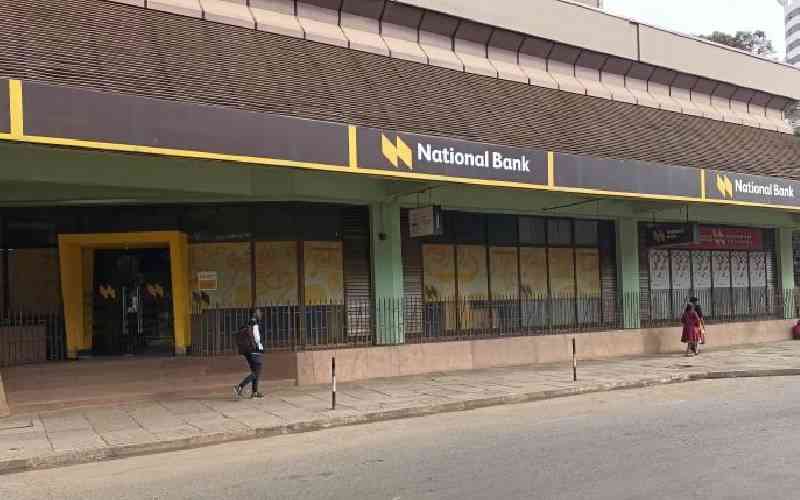
The three State-owned banks have recorded a drop in nine-month earnings as customer deposits shrink.
This has weakened their core capital and left them walking a tightrope.
According to company filings for the period ended September 30 this year, National Bank of Kenya (NBK), Consolidated Bank and Development Bank of Kenya were all in breach of at least one the banking sector’s statutory requirements.
Consolidated Bank soaked in a net loss of Sh203.5 million from Sh16.1 million profit over a similar period last year, while NBK saw its earnings drop 76.9 per cent to Sh521 million.
The 53-year old Development Bank posted a net profit of Sh107.7 million – a drop of 19.5 per cent from the previous period.
Cumulatively, the three banks lost Sh1.98 billion – an 82 per cent drop in net profits in nine months of trading.
For NBK, the dip condemned it to being the least profitable of the 11 lenders listed on the Nairobi Securities Exchange (NSE).
The rest of the listed banks, with the exception of Housing Finance (which made Sh837.7 million in profit), are dining in the billionaire profit club.
Worst performing
The 11 lenders at the stock market saw their net profit increase by Sh8.71 billion (13.4 per cent) to Sh73.7 billion.
In the first nine months of this year, only NBK, Barclays Bank of Kenya (BBK) and NIC Bank saw a drop in profits.
For BBK, profit dropped 5.3 per cent to Sh6.06 billion on account of increased loan loss provisions, while NIC’s profit dipped 25 per cent to Sh3.36 billion.
In addition to NBK’s profit decreasing, year-to-date, its share price at the NSE has shed 49.2 per cent of its value to trade at an average of Sh7.80. This has made it the worst-performing bank stock this year in terms of value shed.
With the nine-month loss, Consolidated Bank, which was the product of a 1989 merger of nine lenders that had become solvent, the bank is now looking for a strategic investor to pump in at least Sh2.5 billion.
Stay informed. Subscribe to our newsletter
The bank’s liquidity ratio slumped to 19.7 per cent against Central Bank of Kenya’s (CBK) threshold of 20 per cent.
This, coupled with a drop in customer deposits and cash assets, may make it challenging for the lender to service obligations falling due in the next 12 months.
The numbers are even lower for Development Bank of Kenya. Against the threshold of 20 per cent, it closed the nine months of the year with a liquidity ratio of 15.1 per cent.
Its liquidity ratio compares poorly against lenders’ like Guarantee Trust Bank (62 per cent), Bank of Baroda (67.4 per cent) and Bank of India (62.5 per cent).
NBK, at just 5.2 percentage points above the minimum level, only beats Housing Finance (23.84 per cent) when compared to other listed lenders. Banks like Stanbic Bank (at 54.7 per cent) and Equity Bank (42.7 per cent) rank higher.
NBK and Consolidated Bank may need to be recapitalised to meet the total capital to total risk weighted assets ratio. The ratio, simply called the capital adequacy ratio, measures how stable a bank is against insolvency. It also shows how much risk a bank can absorb on behalf of its customers.
While NBK’s ratio was at 12.6 per cent, Consolidated Bank’s was at 7.8 per cent – the minimum requirement is 14.5 per cent.
Thin margin
Further, against a required core capital of Sh1 billion, Consolidated Bank has just Sh880 million.
Development Bank, with Sh1.78 billion, beats the requirement by a thin margin. NBK ranks highest of the three with Sh10.2 billion.
Smaller lenders in Kenya suffered a confidence crisis after Dubai Bank, Imperial Bank and Chase Bank were placed under receivership in quick succession. This may have complicated Consolidated and Development banks’ business, as customer deposits dropped.
In the first nine months of the year, Consolidated Bank, which is 78 per cent owned by the Treasury, saw its customer deposits drop by Sh1.76 billion; Development Bank saw a Sh2.54 billion reduction.
In its latest banking report on sub-Saharan Africa, Sterling Capital, a firm that deals in securities in Kenya, said banks will have to rethink their capital levels.
“A specific bank’s capital adequacy levels will have to be considered given the rising NPL [non-performing loans] trends across the region, and to what extent it can absorb losses arising from impaired loans,” it said.
From a balance sheet funding perspective, the analysis by Sterling Capital shows Tier I banks get about 80 per cent of their funding from customer deposits, while some Tier II and Tier III banks get less than 20 per cent of their funding from customer deposits.
Term deposits
This means that more than 80 per cent of funding for smaller lenders is done through term deposits from high-net-worth individuals, Government agencies and institutional investors.
Such term deposits attract interest rates in excess of 10 per cent and may explain why, for instance, despite a fall in customer deposits, the interest paid by Consolidated Bank on deposits rose 10.7 per cent to Sh486.7 million.
In April last year, the Treasury hired a consultant to see if the three State banks could be merged.
However, with Consolidated Bank now searching for a strategic investor, it is not clear if the plan is still in the works. There had also a plan mooted to sell Consolidated and Development banks, but this was put on hold.
Sterling Capital anticipates tough going for low-tier lenders as larger banks diversify revenue sources. The firm added that interest rate caps have put pressure on the industry’s net interest margins (NIMs), with smaller lenders feeling the pinch more.
“While most large Tier I banks have already ventured into growing non-funded income to buffer interest income shortfalls, smaller banks may experience operating challenges with depressed NIMs, which could lead to consolidation in the region,”the firm said.
 The Standard Group Plc is a
multi-media organization with investments in media platforms spanning newspaper
print operations, television, radio broadcasting, digital and online services. The
Standard Group is recognized as a leading multi-media house in Kenya with a key
influence in matters of national and international interest.
The Standard Group Plc is a
multi-media organization with investments in media platforms spanning newspaper
print operations, television, radio broadcasting, digital and online services. The
Standard Group is recognized as a leading multi-media house in Kenya with a key
influence in matters of national and international interest.
 The Standard Group Plc is a
multi-media organization with investments in media platforms spanning newspaper
print operations, television, radio broadcasting, digital and online services. The
Standard Group is recognized as a leading multi-media house in Kenya with a key
influence in matters of national and international interest.
The Standard Group Plc is a
multi-media organization with investments in media platforms spanning newspaper
print operations, television, radio broadcasting, digital and online services. The
Standard Group is recognized as a leading multi-media house in Kenya with a key
influence in matters of national and international interest.








